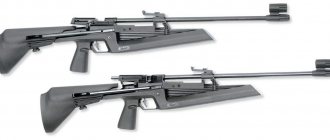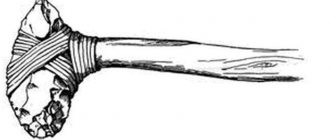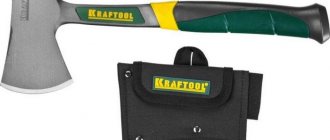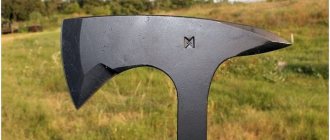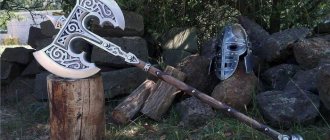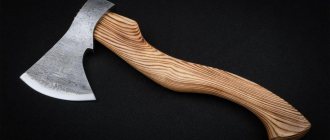Battle ax in Rus'. Helpful Versatility
Old Russian axes from the collection of the State Historical Museum. At the top is a typical emboss. Underneath are axes. Photo: Wikimedia Commons
An ancient Russian warrior could use different types of edged weapons. One of the main weapons was a battle axe. Such a product could be useful on the battlefield and on the march, which contributed to its wide distribution and long-term preservation in service. In addition, over many centuries, battle axes have constantly evolved, giving advantages over the enemy.
Classification problem
To date, several thousand axes of various kinds and types have been discovered in the territories of Ancient Rus'.
At the same time, archaeologists did not always find battle axes used by warriors. Products of a similar design could be used in the national economy or in the military to solve support problems. As a result, it was necessary to create a classification of axes that takes into account the versatility of such products. First of all, the actual battle axes of all varieties and types stand out. In size, they basically did not differ from other axes, but had a smaller blade and were lighter - no more than 450-500 g. They were intended for battles, but could also be used for household needs, although in this regard they were not particularly convenient.
Classification of forms of battle axes from “Ancient Russian weapons” by A.N. Kirpichnikova
Some battle axes were similar to status and ceremonial weapons. Such hatchets were small in size; they were mainly versions of compact hammers. They were richly decorated, corresponding to the status of the owner.
The third main class is working axes. These were larger and heavier samples, designed to perform various jobs. In some situations, working axes were used in battle, but in terms of convenience they were noticeably inferior to specialized models.
Over several centuries of development, axes have repeatedly changed shape, and this applied to both combat and working samples. Only for weapons of the X-XIII centuries. It is customary to distinguish eight different types of blades. They differ in the shape and size of the working part, the presence or absence of a protruding butt, etc.
Ax options
The first mentions of Slavic warriors with axes date back to the 8th century, but archaeological data for that period are extremely scarce. A significant number of finds date back to the 9th and 10th centuries. This was facilitated by the development of the ancient Russian army, the need for mass weapons for the infantry, as well as the active search for new designs and other factors.
Axes from the State Historical Museum. At the top there is a coin with a wide blade. In the middle there is a chase with a reduced butt. Photo: Wikimedia Commons
All known battle axes had a total length of no more than 750-800 mm. The length of the blade rarely exceeded 150-170 mm, and the weight was usually in the range of 400-500 g. Weapons of this configuration were quite convenient to carry and use - primarily in combat. Some of the axes had a hole in the wide part of the blade, which at one time became a topic of controversy. As it was established, a cord was threaded through the hole to secure the protective cover.
The ax itself was forged from iron or steel, depending on the capabilities of the blacksmith. The ax handle used suitable wood, a simple and accessible material.
Probably, hammered battle axes were borrowed from the nomads (type I in the table by A.N. Kirpichnikov). Such a weapon had a narrow and long blade, and also received a hammer-shaped butt. A strike with a hammer could be carried out either with a blade or with a butt, which ensured the effective transfer of energy to the target. In addition, the ax had good balance, which improved the accuracy of the blow.
Different designs of coins. Drawing from the book by A.V. Viskovatov “Historical description of clothing and weapons of the Russian troops”
The hammer-shaped butt could be used with blades of various shapes, from narrow elongated to beard-shaped. There were also butts of shorter length and larger area, designed for impact.
Scandinavian influence explains the appearance in Rus' of ax-axes with a straightened upper edge and a rounded, narrow blade drawn down (type V). This design of the blade made it possible to combine a chopping blow with cutting. There were also similar axes with a concave upper edge and a different butt (type IV).
Also “from the Varangians” came the so-called. wide-bladed axes (type VII) - axes with a triangular or similar blade, symmetrical or with slight asymmetry. It is curious that such samples could be equipped with a longer ax handle. The total length of such a battle ax, unlike other varieties, reached 1 m.
Modern reconstruction of an ancient Russian ax. Photo: Wikimedia Commons
It is curious that only hammered axes were purely military weapons, poorly adapted to solving other problems. The specific configuration of the blade and butt made chopping wood or other work difficult. All other types of battle axes and axes had economic “brothers”. Typically, working axes, while retaining the contours of their parts, differed from combat axes in size and weight.
Battle and working axes of all known types were distributed throughout Ancient Rus' and were actively used by squads. At the same time, in different periods and in different regions, certain designs prevailed. Thus, coinage was more common in the South, near the places of its original appearance, and Scandinavian-style axes were more common in the northern regions. However, nothing prevented the interpenetration of weapons culture and the use of other people's experience.
Simple and massive
A battle ax, regardless of its type, was simpler and cheaper to produce than a sword, although it was inferior in this regard to a spear. As a result, already in the 9th-10th centuries. axes of various types become one of the main weapons of the army. Moreover, unlike other weapons, the ax was used only in infantry. The vigilantes usually used special battle axes, and the militia often had to take workers.
Russian axes. Drawing from the book “Antiquities of the Russian State, Published by the Highest Order”
In battle, the ax was useful due to its accuracy and striking power. In addition, it made it possible to combat enemy defenses. A successful blow was capable of splitting a wooden shield, and chain mail or soft armor could not protect the warrior from the crushing effect.
The battle ax retained its position until the 12th century, when the situation began to change. In archaeological complexes dating from the 12th-13th centuries, axes are found in significant quantities, but with many copies, swords, etc. Whenever possible, warriors replaced the ax with a more convenient weapon with a long blade, while the militias retained it.
Despite the reduction in their role, battle axes remained in service. In addition, their development continued. The evolution of such weapons was associated with ax-axes of all versions. The shapes and configurations of the blade and butt changed, and the handle was modified. Subsequently, these processes led to the appearance of a wide moon-shaped blade, on the basis of which the reed was created. Its final form was determined in the 15th century, and with certain changes, such weapons served for several centuries.
Reeds of different configurations. Drawing from the book by A.V. Viskovatov “Historical description of clothing and weapons of the Russian troops”
In parallel with battle axes, the troops used similar models for economic purposes. With their help, the construction of various structures, the organization of engineering barriers, etc. were carried out. It is noteworthy that the ax remains in our army as a working tool to this day, although its combat varieties are long gone into history.
Helpful Versatility
The first battle axes appeared among the Slavs almost in the middle of the first millennium AD, and later such weapons became the most important attribute of the ancient Russian warrior.
For several centuries, battle axes of various types were used along with other infantry weapons. However, the further development of the army, the growing importance of cavalry and new threats to the infantry led to rearmament and changes in the range of basic equipment for the infantryman. The role of battle axes was reduced; some of their tasks were now solved with the help of swords and sabers. However, the development of axes did not stop and led to the emergence of new types of edged polearms.
Subsequently, these samples were withdrawn from service due to final obsolescence. Despite all this, working axes have not gone away. They remained in the army and the national economy and did their own thing. The versatility and ability to perform different tasks turned out to be useful - and after leaving the battlefield, the axes were not left without work.
What's the difference between an ax and a sword?
Slavic sword.
A sword is a bladed weapon with a straight blade. The long bladed device delivers slashing and piercing blows. Advantages of the sword:
- the location of the center of gravity near the guard makes it maneuverable and fast;
- by sharpening the blade, the affected area increases;
- There are many fencing techniques.
An ax is a cutting device with a short blade. It was used not only in battles, but also for economic purposes. The main differences between the guns:
Old Russian hatchet.
a sword has more speed than an axe;- a chopping blow with a sword is applied only at a certain angle;
- It is difficult to inflict blunt trauma with a sword;
- blade length and product shape;
- producing an ax is cheaper and easier.
A few words about safety precautions
- Use a proper axe.
- Place your feet so as not to get hurt if you fall—shoulder-width apart.
- Do not work if there is alcohol in your blood.
- Make sure that there are no strangers on the lines of impact and swing.
- Do not hold the target with your hand when chopping small branches.
- Move parallel to the trunk when limbing.
- Choose a block 80-90 cm in diameter.
- Hold the ax with both hands.
Forged hatchets, unlike stamped models, are distinguished by their quality and reliability. Even at a high cost, products can pay for themselves in a couple of years, especially in conditions of intensive use.
Subscribe to the Military Observer channel in Yandex.Zen
News Media2
How to forge
To make such a tool using the forging method, you will need a steel blank in the form of a strip of appropriate dimensions. For convenience, it can be welded at one end to a piece of reinforcement so that the workpiece can be manipulated during operation.
After heating, one of its ends is slightly accelerated and beveled; this will be the future blade.
The shank also needs to be slightly accelerated and prepared for bending. After that, the workpiece is heated and the eye is bent on the toe of the anvil.
The connection of the bent end to the surface of the workpiece is carried out using forge welding.
The next step is to form the blade, while also using the method of dispersing the metal. It can be made more elongated by making a longer beard.
After formation, it is polished and hardened. In this case, heating temperature conditions must be observed. The main thing is not to overheat or burn the metal.
A hardened ax can be ground or even polished. Also, as an option, steel is etched with ferric chloride, from which the metal acquires a gray-matte tint, and its resistance to corrosion increases significantly.
Labrys
The most famous ax of that time was Labrys. It had two large ax blades in different directions. At that time, the production of such axes was a very difficult (technically) process and, usually, these weapons were made for leaders and great warriors. In addition, it had an impressive size and weight, so not every person could deftly wield it.

